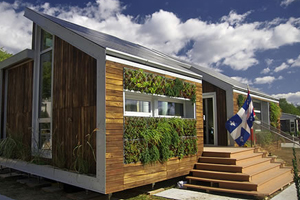
 Chevrolet is harnessing the power of the sun to install solar-powered electric
Chevrolet is harnessing the power of the sun to install solar-powered electric  charging stations for its Volts at dealerships in North America. The Green Zone initiative will generate electricity equivalent to 12 full vehicle charges per day and excess electricity created will help supplement the dealership’s power needs. “The Chevrolet Green Zone will provide our U.S. dealers with added flexibility when it comes to charging their vehicles, while also reinforcing GM’s commitment to renewable energy projects,” said Chris Perry, vice president, Global Chevrolet Marketing and Strategy.
charging stations for its Volts at dealerships in North America. The Green Zone initiative will generate electricity equivalent to 12 full vehicle charges per day and excess electricity created will help supplement the dealership’s power needs. “The Chevrolet Green Zone will provide our U.S. dealers with added flexibility when it comes to charging their vehicles, while also reinforcing GM’s commitment to renewable energy projects,” said Chris Perry, vice president, Global Chevrolet Marketing and Strategy.
American Chevrolet in Modesto, Calif., and Al Serra Auto Plaza in Grand Blanc, Mich., are the first U.S. dealerships to complete their solar charging capability by installing Green Zones on their property. “The question isn’t whether to install a solar canopy, it’s where and how many,” said Joe Serra, president of Serra Automotive. “It’s a win for us because the electricity generated will help reduce operating costs, and it’s a win for the environment since solar power helps reduce our carbon footprint.”Each canopy generates enough electricity for up to 4,500 charges per vehicle annually. The proof of concept for the Green Zone project is housed at the Detroit Hamtramck assembly plant, manufacturing home of the Volt.
BLADE RUNNER
“The beauty of this program is that there is no capital cost required from the dealership,” said Dave Halvorson, president of American Chevrolet in Modesto. “Not only do we generate the solar energy to increase our reliance on renewable electricity, but the Green Zone is a billboard of our commitment to the environment.”The Chevy Green Zone Initiative is part of GM Ventures’ recent announcement to invest $7.5 million in Sunlogics, a solar panel manufacturing and development company that will supply the panels and install the dealer charging stations. Both American Chevrolet and Al Serra Chevrolet partnered with Sunlogics for installation of their Green Zones.”Just one of these canopies provides enough renewable energy to power two to three homes per year, or more than 25 percent of a dealership’s energy consumption,” said Perry. “Collectively, that will be a lot of power we are putting back into the grid.”
COAL vs. ENVIRONMENT











